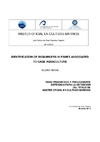Please use this identifier to cite or link to this item:
https://accedacris.ulpgc.es/jspui/handle/10553/85982
| DC Field | Value | Language |
|---|---|---|
| dc.contributor.advisor | Haroun Tabraue, Ricardo Jesús | - |
| dc.contributor.advisor | Montero Vítores, Daniel | - |
| dc.contributor.author | Mouna, Abaab | - |
| dc.date.accessioned | 2021-03-10T23:27:59Z | - |
| dc.date.available | 2021-03-10T23:27:59Z | - |
| dc.date.issued | 2012 | en_US |
| dc.identifier.other | Gestión académica | - |
| dc.identifier.uri | https://accedacris.ulpgc.es/handle/10553/85982 | - |
| dc.description.abstract | During the last decades, the increasing fish-farming activity in coastal areas have lead to a larger amount of nutrient wastes discharged into the water column and nearby sediments, which may dissipate or, alternatively, enter coastal trophic chains. The study was done in the Canary Islands (Central Eastern Atlantic), which are characterized with exposed and oligotrophic waters, at several distances from 2 different fish farms rearing Sea bass (Dicentrarchus labrax). The selected biomakers studied were fatty acid profiles, body and scales morphometries and otolith weight and otolith shape analysis. Four fish species representing different trophic guild levels were analyzed: a carnivorous/predator (Yellowmouth barracuda: Sphyraena viridensis), a herbivor (Salema: Salpa salpa), a sediment-feeder (Surmullet: Mullus surmuletus) and a plankton-feeder (Bogue: Boops boops). In this contribution, we shall discuss the main results obtained by analyzing the efficiency of those biomakers as a tool to differentiate fishes associated to aquaculture farms comparing them with wild fishes and fishes associated to seawage. | en_US |
| dc.language | eng | en_US |
| dc.subject | 310502 Piscicultura | en_US |
| dc.subject.other | Biomarker | en_US |
| dc.subject.other | Fatty acid profile | en_US |
| dc.subject.other | Morphometry | en_US |
| dc.subject.other | Scale morphometry | en_US |
| dc.subject.other | Otolith morphometry | en_US |
| dc.subject.other | Otolith weight | en_US |
| dc.subject.other | Aquaculture | en_US |
| dc.title | Identification of biomarkers in fishes associated to cage aquaculture | en_US |
| dc.type | info:eu-repo/semantics/masterThesis | en_US |
| dc.type | MasterThesis | en_US |
| dc.contributor.facultad | Facultad de Ciencias del Mar | en_US |
| dc.investigacion | Ciencias | en_US |
| dc.type2 | Trabajo final de máster | en_US |
| dc.utils.revision | Sí | en_US |
| dc.identifier.matricula | TFT-30498 | - |
| dc.identifier.ulpgc | Sí | en_US |
| dc.contributor.buulpgc | BU-BAS | en_US |
| dc.contributor.titulacion | Máster Universitario en Cultivos Marinos | - |
| item.grantfulltext | open | - |
| item.fulltext | Con texto completo | - |
| crisitem.advisor.dept | GIR ECOAQUA: Biodiversidad y Conservación | - |
| crisitem.advisor.dept | IU de Investigación en Acuicultura Sostenible y Ec | - |
| crisitem.advisor.dept | Departamento de Biología | - |
| crisitem.advisor.dept | GIR Grupo de Investigación en Acuicultura | - |
| crisitem.advisor.dept | IU de Investigación en Acuicultura Sostenible y Ec | - |
| crisitem.advisor.dept | Departamento de Biología | - |
| Appears in Collections: | Trabajo final de máster | |
Page view(s)
52
checked on Jan 27, 2024
Download(s)
33
checked on Jan 27, 2024
Google ScholarTM
Check
Share
Export metadata
Items in accedaCRIS are protected by copyright, with all rights reserved, unless otherwise indicated.
